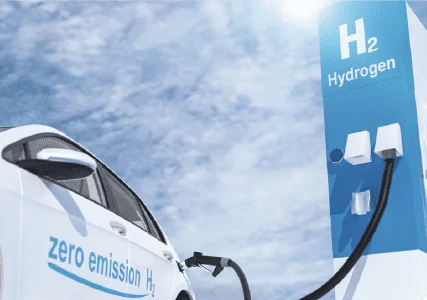Hydrogen – An emerging and promising industry for Alberta and Saskatchewan

Despite being the smallest element, hydrogen is one of the most abundant elements on Earth and is the most abundant element in the universe. Hydrogen is naturally colourless and odourless, but when combined with other elements, it forms various flammable gases.
When pure hydrogen is burned for energy or used in a fuel cell, it emits only water. This is contrasted with the combustion of natural gas and other petroleum products which form carbon dioxide, sulfur oxides and nitrogen oxides.
However, as hydrogen is only an ‘energy carrier,’ the energy itself needs to have a source. The source of the energy hydrogen carries determines the classification of the hydrogen produced. There are two main types:
Blue hydrogen: the production of blue hydrogen uses steam to convert natural gas to carbon dioxide and hydrogen. The energy that is released during this conversion is captured and subsequently stored by the hydrogen to be used at a future time. Carbon capture, utilization and storage (CCUS) is used to mitigate the release and effects of carbon dioxide produced alongside the blue hydrogen.
Green hydrogen: the production of green hydrogen uses electrolysis, which involves passing electricity though water to separate it into its component parts, oxygen and hydrogen. What makes this type of hydrogen ‘green’ is that the electrolysis is powered by renewable sources, namely wind, hydro and solar.
While both types are viable options for the world’s future hydrogen needs, currently the costs of producing green hydrogen are higher than those associated with producing blue hydrogen. In addition, there are many other types of hydrogen – each distinguished by the means through which it is produced.
By 2050, the global hydrogen market is estimated to be worth more than $2.5 trillion. As of now, the refining and industrial sectors drive global hydrogen demand. However, hydrogen demand is expected to expand into other sectors, including transportation, heating and power generation.
Current developments and incentives
Alberta is the largest hydrogen producer in Canada and is a world leader in both hydrogen production and CCUS. Alberta’s Industrial Heartland region is one of Canada’s first hydrogen-producing hubs. With access to significant natural gas reserves, potential CCUS sites, two CO2 pipelines and an existing hydrogen pipeline, Alberta is well-positioned to grow its hydrogen production. As demand for hydrogen increases, the province has the potential to be a major player in clean hydrogen production, transportation and use.
Many companies have announced hydrogen projects in Alberta. Air Products recently announced the construction of Western Canada’s first hydrogen liquification facility, and Suncor and ATCO have plans for a jointly built green hydrogen facility (both to be located in Alberta’s Industrial Heartland region). International corporations also have their eye on Alberta’s hydrogen sector: Japan’s ITOCHU Corporation, in partnership with Petronas Energy Canada, announced a natural gas-based ammonia facility with CCUS to be built in Alberta to export ammonia to Asian markets.
Hydrogen is also set to play an increasing role in consumer markets. The Alberta Zero Emissions Truck Electrification Collaboration is testing hydrogen’s ability to fuel the province’s heavy freight transportation sector, and Canadian Pacific Railway is testing hydrogen fuel cell use in freight rail locomotives. Qualico and ATCO have proposed the development of a new hydrogen-powered residential neighbourhood east of Edmonton. It has already received $2 million in funding from the Alberta Hydrogen Centre of Excellence. Further, the Invest Alberta Corporation, Alberta Transportation and the Canadian Infrastructure Bank are assessing a Calgary to Banff hydrogen-powered passenger rail project.
Similar developments are happening in Saskatchewan, with the potential for a hydrogen/CCUS hub in the Regina area.
As for incentives, the federal government has made a tax credit available for investments in clean hydrogen production. The percentage of credit available depends on the amount of carbon dioxide that is produced during hydrogen production, as well as the working conditions of the project itself. The maximum tax credit is 40%.
Alberta offers the Alberta Petrochemicals Incentive Program (APIP), which provides funding to all eligible projects that applied once built and operational, and up to 12% of a project’s eligible capital costs as a grant. In addition to incentives like APIP, Alberta’s innovation agencies, including Emissions Reductions Alberta and Alberta Innovates, have provided over $92 million in funding to 35 hydrogen projects.
Considerations
As with any emerging sector, the hydrogen industry will require a transparent and competitive regulatory framework for it to flourish. In both Alberta and Saskatchewan, the relevant legislative regimes are closely tied to CCUS, facility licensing and water use – there is currently no hydrogen-specific legislation. However, it is likely that as the hydrogen sector grows, governments will enact legislation specific to hydrogen production and investment.
With current technology and efficiency, the construction of hydrogen facilities – both blue and green – is not overly cost effective. As with the renewable energy industry, high investment costs and an overall dependency on government support impact short-term investment decisions. De-risking hydrogen investment will require government and industry to work together to send coordinated signals to the market.
Hydrogen-related developments may have a difficult time acquiring rights to land as there will be increased competition for land leases with other growing commodities. Oil and gas, CCUS (whether relating to a blue hydrogen project or not), helium, lithium, geothermal and hydrogen developers will all be competing for development space; thus, jurisdictions will be required to adapt and design regulations necessary to avoid future property rights and management issues.
Lastly, investment into clean hydrogen industries in both Alberta and Saskatchewan will depend heavily on climate change policies and the government’s level of industry support. Thankfully, the Government of Alberta has already presented a framework to encourage development of the local clean hydrogen market. In late 2021, the Government of Alberta released its Hydrogen Roadmap: a plan to secure more than $30 billion in capital investments and establish Alberta as a leading supplier of clean hydrogen for the world’s growing hydrogen demand. The Hydrogen Roadmap focuses efforts on developing blue hydrogen production in Alberta, which would provide a significant opportunity for both hydrogen producers as well as natural gas producers and those involved in the CCUS space.
MLT Aikins has extensive experience advising clients on various legal, regulatory and commercial matters involving energy projects. Our mandates have included hydrogen and CCUS projects, land acquisitions and the development, refurbishment, financing, construction, commercialization, operations and maintenance, and acquisition/divestment of utility-scale wind, solar, geothermal, nuclear, biomass and hydroelectric projects. Our integrated energy practice team brings together some of Canada’s top corporate/commercial, Indigenous, M&A, finance, ESG, regulatory and environmental lawyers to help our clients successfully navigate each step of the process.
If you’re interested in advancing a project within Western Canada’s evolving energy landscape, we would be delighted to speak with you. Contact us to learn how we can help.
Note: This article is of a general nature only and is not exhaustive of all possible legal rights or remedies. In addition, laws may change over time and should be interpreted only in the context of particular circumstances such that these materials are not intended to be relied upon or taken as legal advice or opinion. Readers should consult a legal professional for specific advice in any particular situation.





